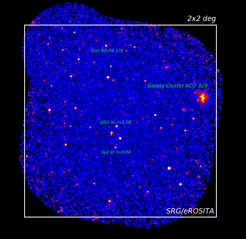A glimpse of extragalactic sky with the SRG Observatory: eROSITA opens its first eye
The SRG Observatory was launched from Baikonur by a Proton-M launcher and DM-03 booster on 13 July 2019 and is now near the L2 point of the Sun-Earth system, some 1.6 million kilometers away from Earth. It is going to spend its time in a wide orbit around L2, and, for the first four years, will be mapping the sky in a fashion similar to its predecessor ROSAT as well as the WMAP, Planck and Gaia observatories.
SRG carries two X-ray telescopes – eROSITA (developed by MPE, Germany, working at lower X-ray energies) and ART-XC (developed by IKI, Russia, working at higher X-ray energies). The main goal of the mission is to map the entire X-ray sky in the soft (0.3-8 keV) and hard (4-20 keV) bands with unprecedented sensitivity and discover about 3 million of accreting supermassive black holes, 100 000 galaxies clusters, numerous X-ray binary systems, X-ray-active stars and map the diffuse emission of our Galaxy. The success of the mission relies as much on the sensitivity of the telescopes as on the ability of the spacecraft and receiving stations on the ground to perform observations 24 hours per day for 4 years uninterruptedly.

Shown in the image are the results of observations of a small patch of extragalactic sky (2x2 degrees) observed on 26 and 27 August 2019 with one of the eROSITA modules. The central area (~1x1 degrees) of this field is known as UDS (Ultra Deep Survey). The test observations include both pointed and scanning-mode observations, which are combined in the image shown. The effective exposure time at the center of the field is equivalent to some 6ks (approximately two hours) of observations with all 7 modules.
Most of the hundreds of objects visible in the image are QSOs (quasars) at cosmological distances, but some correspond to Active Galactic Nuclei of not very distant galaxies, and there are even some stars with very bright X-ray coronae in our own galaxy. The very prominent diffuse blob visible in the top-right corner is a massive cluster of galaxies (known as ACO329) at redshift z=0.139.
To the delight of the teams responsible for SRG operations in Russia and Germany, the very first tests of the Observatory were remarkably successful for both eROSITA and ART-XC.
Simultaneous observations of eROSITA and ART-XC will provide spectra of bright sources in a broad X-ray energy range, thus allowing for quick classification of such sources. Although very preliminary, first images from eROSITA and ART-XC (published already on IKI and ROSKOSMOS sites, see here) demonstrate the potential of the mission. There is, of course, much more work ahead with tuning and calibrating the instruments before SRG will reach its full power.
Note: This news is issued on behalf of the German and Russian SRG/eRosita consortia.












